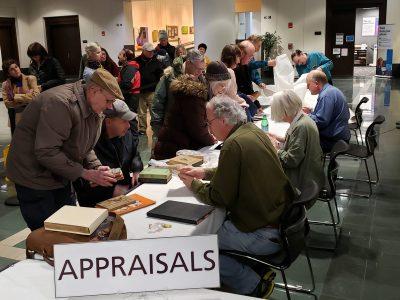While one may deem tan, antique documents as dull and lifeless, looking past their wrinkles can bring out the life and history within the fading text.
This weekend, the 43rd Boston International Antiquarian Book Fair was held at the Hynes Convention Center by the Antiquarian Booksellers’ Association of America and International League of Antiquarian Booksellers.

The event brings together exhibitors from all over the world to showcase items such as rare books, illuminated manuscripts and decorative prints.
Unique items on display over the weekend included one of three surviving Catholic missals from Prague in 1522, a first edition print of F. Scott Fitzgerald’s “The Great Gatsby” and the original blueprint of the slave ship Brooks, which includes illustrations of slaves lining the entirety of the ships’ lower deck.
Stephen Hanly, who brought the blueprint of the slave ship from Bickerstaff’s Books, a bookstore in Maine specializing in early American books and maps, said the print was impactful towards abolitionist ideas in the U.S.
“Slavery was controversial in its day,” Hanly said. “This image is credited with creating a lot of anti-slavery sentiment.”
Rather than being displayed behind thick glass, the blueprint was laminated for attendees to be able to pick it up and inspect it for themselves.
Bill Mahn, 52, from Cambridge, attended the book fair and said holding the image of a slave ship brings about an intense and sobering feeling of injustice in him.
“There’s just something about holding a piece of history that’s so powerful,” Mahn said.
Simon Beattie, an independent bookseller, attended the event over the weekend. His collection consists mostly of antique literature, but also includes visuals such as colorful publishing posters from the early 1900s.
Beattie said in order to stand out amongst hundreds of other vendors at fairs, he brings such visuals to events to entice attendees.
“Publishing posters were used to advertise any new novels of the time, like the modern movie posters,” Beattie said. “For events like this, I like to bring visual material.”
Purchasing items with storied histories gives people the ability to own a segment of the past, Beattie said.
“Owning a piece of history is sort of like going back to vinyl,” Beattie said. “It’s a record of human history.”
Michael Laird, the owner and proprietor of Michael Laird Rare Books and Manuscripts, said his motivation for choosing to purchase antiques is fully based out of love.
“Our collection is 100 percent eclectic and all over the map,” Laird said. “We buy visually appealing things, unusual things, anything that we love. There’s no justification for anything other than that it is loved.”
Laird’s collection includes items such as the first illustrations of neurological surgery written and illustrated in Italy in 1574, an original Dr. Pepper soda advertisement from the early 1960s and “Le Decor Floral,” a 1904 collection of photographs that depict geometrical patterns made up of flowers and plants.
Laird said each antique symbolizes a particular zeitgeist. When considered separately, they paint a picture of that particular moment, but together the antiques form an odd puzzle displaying each and every corner of human history.
“Antiques allow us to invest ourselves into humanity, to make a reflection to modernity about what has happened and what will happen,” Laird said. “If we study history, then we affirm that humanity is worthwhile.”
Correction: A previous version of this article incorrectly stated that Simon Beattie works for Bernard Quaritch. This version of the article has been updated to reflect this change.


























































































































